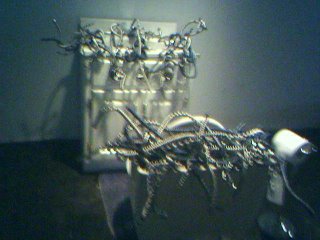Several things immediately pop into the mind about the piece MORI. The movie Journey into the Center of the Earth, the religion of the Plains Native Americans, John Cage, Personification, Baroque Art and last but never the least of all the Earth, all collide when experiencing this piece. MORI is an installation piece that uses the web to allow participants in Vienna, Virginia to experience not only seismographic information collected at Berkeley, California but also the rest of the world.
A black curtain allows you to take a short journey to the heart of the earth, or at least an interpretation of the movements of the Earth. Oftentimes we neglect to acknowledge that the world actually speaks to us and is a living thing. A majority of the Native American religions used the earth as a focus on the wonderment of life. With our fast paced world of skyscrapers and noise canceling headphones it is easy to forget that a longer more eternal story is constantly being told.
If we gave the earth a symphony what would it play?
MORI concentrates the senses acutely so that sound, vibrations, and the perception of light's movement are all synchronized. The sounds have the same overwhelming presence of seeing and hearing a virtuoso live. Music has the ability to communicate past traditional linguistic languages. John Cage a composer of "experimental" music, often toyed with the rules and expectations of musical forms. MORI plays with our knowledge of traditional music by stretching the meaning of live performance, rhythm, tension and resolution, chance and composition.
Our fascination with the unknown rears its head time and time again in cinema. What would happen if we could? Well MORI allows us to take a "journey" into the earth, to become more acutely aware of movement that is usually undetected by the range of human senses. After you leave, you still for at least a little while, have that sense of being grounded or more in tune with the previously unobserved. You've
seen the inside of the earth.
Perhaps the name MORI which can be interpreted as the Japanese word for "Forest Sanctuary" or perhaps an allusion to the beautiful Renaissance and baroque paintings of religious subjects that always included a memento mori. These paintings were commissioned with the purpose to give "glory to god." This piece could also be seen a call to remember the glory and magnificence of the earth. Of what gives life but is almost always mistaken as an unchanging, dead and unfeeling thing. It reminds us to listen closer to what the earth may be telling us.


